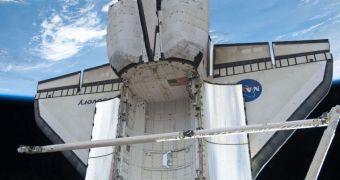Tomorrow, Wednesday, will mark a historic moment in the history of the space shuttle program, namely the retirement of the first of three orbiters NASA operated for nearly three decades. Discovery is due to make its final landing on March 9.
The spacecraft is now in low-Earth orbit (LEO), and the six-astronaut crew onboard is spending today, March 8, packing all their things neatly, and ensuring that the ship is ready to reenter the atmosphere.
Discovery is due to land at the Kennedy Space Center (KSC), in Florida, at 11:57 am (1657 GMT), and weather forecasts are looking good for two attempts tomorrow.
This is a very dangerous stage in the return process. The orbiter will need to undergo rapid descent through the upper layers of the atmosphere, and will get heated to thousands of degrees.
Astronauts have already carried out the mandatory heat shield inspection yesterday, when they used a robotic arm and a sensor pole to check individual ceramic tiles in the shield for damage.
According to NASA officials, everything is looking good at this point. The results of the inspection made before Discovery docked to the International Space Station (ISS) were also good.
Throughout today, the crew members will perform a series of duties, including packaging all the items in the shuttles neatly into their respective positions. They will also need to carry out a so-called Reaction Control System (RCS) test.
At that time, they will fire off each individual orbital maneuvering thruster that the shuttle has. It is vitally important that all of them work properly, if the orbiter is to be set on the correct course and inclination for atmospheric reentry.
The astronauts will also participate in a series of in-flight interviews starting at 11:23 am EST (1623 GMT), and are then scheduled to go to bed at around 7:23 pm EST (0023 GMT).
In the mean time, they will also send down a commemorative message for the shuttle, NASA's oldest flying orbiter, and the veteran of the space fleet. The craft flew 39 missions, of which 13 to the ISS.
It is also the first one to retire from active duty, after no less than 27 years of service. Discovery's last mission will be followed by Endeavor's (STS-134) in April, and Atlantis' (STS-135), in June.
During STS-133, Discovery delivered a new cargo module on the station, an external storage platform, and the Robonaut 2 robotic assistant, which was developed by NASA and General Motors as a permanent resident of the ISS.
The crew aboard Atlantis will have the honor of flying the very last shuttle mission ever. All orbiters are to be retired this year, and put on permanent or temporary displays at museums across the United States, Space reports.

 14 DAY TRIAL //
14 DAY TRIAL //